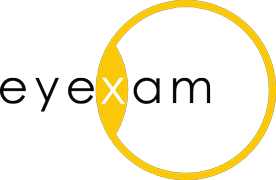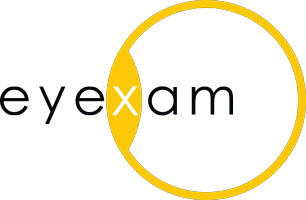Each year, nearly 50 percent of the annual 2.5 million eye injuries occur at home; that’s more injuries than occur in school and at the work place – combined. From cleaning and cooking to mowing and repairing, eye injuries occur every day while performing routine activities. When completing these daily tasks in and around the home, we often become complacent and do not take proper safety precautions. During Home Eye Safety Month Friends for Sight hopes you will start taking necessary safety measures to reduce your risk of eye injury.
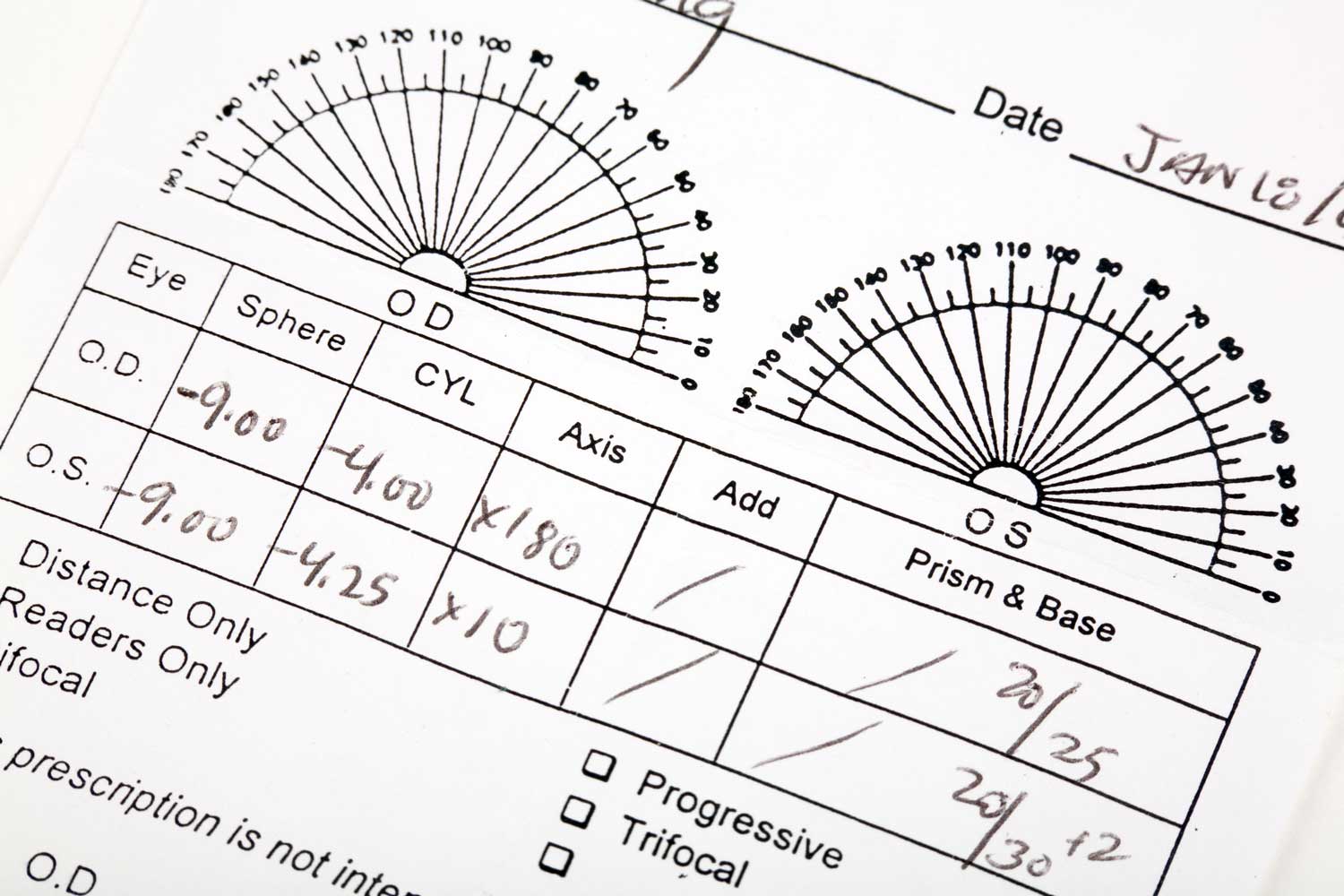
Understanding Your Eye Glass Prescription
Navigating the world of eyecare can sometimes feel like trying to understand a foreign language, especially when it comes to your eyeglass prescription. At eyeXam, we believe in empowering our patients with knowledge, making it easier for you to understand your vision needs and make informed decisions about your eyewear. This detailed guide aims to demystify the numbers and symbols on your prescription, ensuring you know exactly what they mean for your vision correction.
The Basics of an Eyeglass Prescription
An eyeglass prescription is a unique set of parameters determined by your optometrist that specifies the correction needed for your vision. It might seem like a complex mix of numbers and abbreviations, but each part has a specific meaning related to your eye health and how your eyeglasses should be crafted to correct your vision.
Understanding the Key Components
- Sphere (SPH): This number indicates the power of the lens required to correct your vision. Measured in diopters, it shows whether you are nearsighted (-) or farsighted (+). The higher the number, the stronger the prescription lens needed.
- Cylinder (CYL) & Axis: These values pertain to astigmatism correction. CYL indicates the lens power needed to correct the astigmatism, while the Axis number (ranging from 0 to 180 degrees) specifies the orientation of the astigmatism in your eye.
- Add: This number is relevant for bifocal or multifocal lenses, signifying the additional magnifying power needed at the bottom part of the lens for reading or close work.
- Pupillary Distance (PD): PD measures the space between the centers of your pupils in millimeters, ensuring that the lenses are correctly aligned with your eyes for optimal focus.
Decoding the Prescription: A Step-by-Step Guide
- Sphere (SPH): Look for the “SPH” abbreviation. If you see a plus sign (+), you have hyperopia, meaning you see well at a distance but have difficulty with close-up tasks. A minus sign (-) indicates myopia, where near objects are clear, but distant ones are blurry.
- Cylinder (CYL) and Axis: Not everyone will have values here, as they only apply if you have astigmatism. A nonzero CYL number means you have astigmatism, requiring correction for distorted or blurred vision at all distances. The Axis value will tell the lens maker at what angle the correction should be applied.
- Add Power: This section is particularly crucial for those over 40 who might be experiencing presbyopia, the age-related difficulty in focusing on close objects. The “Add” value represents the extra magnification needed to assist with reading or other close-up activities.
- Prism: Although less common, some prescriptions include prism correction to help with alignment issues for those who have binocular vision problems, reducing double vision or eye strain.
- Pupillary Distance (PD): This measurement might not always be on your prescription, but it’s vital for ensuring your glasses fit perfectly. If it’s missing, eyeXam can measure it for you during your fitting.
Why Precision Matters
Getting every detail of your prescription right is crucial for your comfort and vision clarity. Incorrect or outdated prescriptions can lead to headaches, eye strain, and blurred vision, significantly impacting your daily life. That’s why at eyeXam, we emphasize the importance of regular eye exams and precision in every prescription we issue.
Tips for Reading Your Prescription
- Always ask questions: If any part of your prescription is unclear, don’t hesitate to ask your optometrist for an explanation. Understanding your prescription can help you make better choices about your eyewear.
- Keep it updated: Vision can change over time, so it’s essential to have your eyes checked regularly and keep your prescription up to date.
- Know your rights: Remember, your eyeglass prescription is yours to keep. You’re entitled to a copy of it after your eye exam, allowing you to shop for eyewear anywhere you choose.
How eyeXam Can Help
At eyeXam, we’re dedicated to providing personalized care and educating our patients about their eye health. Our team of experienced optometrists uses the latest technology to ensure accurate prescriptions and answers all your questions about your vision correction needs.
Choosing the right eyewear goes beyond just style; it’s about comfort, functionality, and, most importantly, your health. By understanding your eyeglass prescription, you’re taking an important step towards optimal eye health and vision quality. Visit eyeXam for your next eye exam, and experience the difference that clarity and knowledge can make in your vision and life.
Remember, your prescription is a key to better vision. Understanding it is the first step in ensuring your eyewear not only corrects your vision but also supports your overall eye health. At eyeXam, we’re here to guide you through every step of that journey, providing expert care and advice tailored to your unique vision needs.
Read More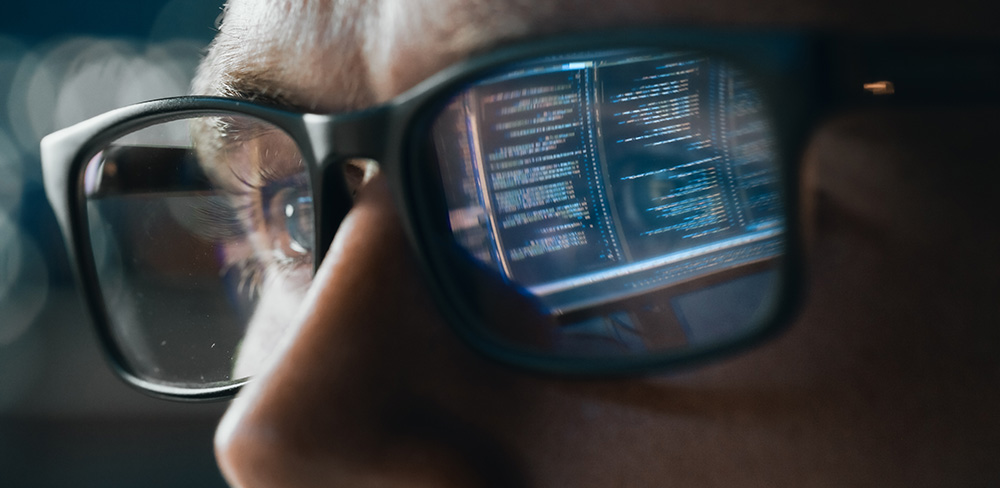
Understanding the Difference Between Computer Vision Glasses and Blue Light Blocking Glasses
In our modern era, where screens are an integral part of our daily lives, concerns about eye strain and fatigue have become increasingly prevalent. As a response to these concerns, two types of eyewear have gained popularity: computer vision glasses and blue light blocking glasses. While both aim to address the visual challenges posed by prolonged screen exposure, they serve distinct purposes and offer unique benefits.
Computer Vision Glasses: A Focus on Enhanced Visual Comfort
Computer vision glasses, also known as digital screen glasses or computer glasses, are specifically designed to optimize the visual experience for those spending extended hours in front of digital devices. These glasses are equipped with special coatings and filters that aim to reduce glare, enhance contrast, and minimize eye strain caused by prolonged screen time.
One key feature of computer vision glasses is their ability to filter out a portion of the high-energy visible (HEV) blue light emitted by digital screens. HEV blue light is known to contribute to eye strain, disrupt sleep patterns, and potentially cause long-term damage to the eyes. By selectively blocking a certain amount of blue light, computer vision glasses aim to create a more comfortable viewing experience, especially for individuals who work extensively with computers or engage in frequent digital activities.
Moreover, computer vision glasses often incorporate an anti-reflective coating, which helps reduce glare from screens and other sources of artificial light. This anti-glare feature not only enhances visual comfort but also contributes to a clearer and more focused vision, ultimately reducing the strain on the eyes.
Blue Light Blocking Glasses: Shielding Your Eyes From Harmful Light
Blue light blocking glasses, on the other hand, have a broader purpose beyond addressing the challenges of digital screens. While they do filter out a significant amount of blue light, their primary function is to protect the eyes from the potential adverse effects of prolonged exposure to blue light in various environments.
Natural sunlight is the primary source of blue light, and it plays a crucial role in regulating our circadian rhythm and boosting alertness. However, the increasing prevalence of artificial sources of blue light, such as LED lights and digital screens, has raised concerns about potential disruptions to sleep patterns and eye health.
Blue light blocking glasses utilize specialized lenses that absorb or block a significant portion of blue light, preventing it from reaching the eyes. By doing so, these glasses aim to mitigate the negative impacts of excessive blue light exposure, including digital eye strain, headaches, and sleep disturbances.
Benefits of Computer Vision Glasses and Blue Light Blocking Glasses
- Reduced Eye Strain: Both types of glasses work towards reducing eye strain caused by extended screen time. By optimizing the visual experience and minimizing glare, users often experience less discomfort and fatigue.
- Improved Sleep Quality: Blue light blocking glasses, in particular, can be beneficial in improving sleep quality. By reducing exposure to blue light, especially during the evening hours, these glasses may help regulate the circadian rhythm and promote better sleep.
- Enhanced Visual Clarity: Computer vision glasses with anti-reflective coatings contribute to enhanced visual clarity by reducing glare. This feature is particularly valuable for individuals working in environments with bright artificial lighting.
- Prevention of Potential Eye Damage: While both types of glasses aim to protect the eyes, blue light blocking glasses specifically target the potential long-term effects of prolonged exposure to blue light. This may include reducing the risk of digital eye strain and preserving overall eye health.
In conclusion, the choice between computer vision glasses and blue light-blocking glasses depends on individual needs and preferences. For those primarily concerned with optimizing their digital screen experience, computer vision glasses may be the preferred option. On the other hand, individuals looking for comprehensive protection against the harmful effects of blue light in various environments may find blue light blocking glasses to be more suitable. Ultimately, both types of eyewear contribute to creating a more comfortable and visually optimized experience in our increasingly digital world.
Visit our Newport Beach Optometry practice or our Santa Clara Optometry practice to learn more about both options.
Read More
PhotoFusion X by ZEISS: The Most Advanced Photochromic Lens Technology
ZEISS PhotoFusion X is a comprehensive photochromic lens portfolio that has been specifically engineered to meet your patients’ needs for speed-to-clear, blue light protection, and UV protection. ZEISS has redesigned its photochromic system to provide industry-leading transition speeds, increased darkness, superior UV and blue light protection, and appealing hues – all while maintaining ZEISS quality. This new photochromic lens was introduced by ZEISS at Vision Expo East in New York.
What Makes it Different
Your patients will be protected both indoors and out thanks to cutting-edge photochromic technology that uses ZEISS BlueGuard as a base material and features the sunglass-level UV protection of ZEISS UVProtect. In any scenario, the new ZEISS PhotoFusion X provides exceptional blue light and UV protection.
A Brand-New Photochromic System
ZEISS PhotoFusion X lenses have a far more efficient photochromic technology than prior self-tinting lenses. It contains a new generation of specially created and patented dyes in a more open carrier matrix for faster transition, allowing them to be clearer indoors, darker outdoors, and react faster than prior generations.
Speed in Transition is Important
Patients commonly purchase a variety of prescription lenses, including clear lenses, sunglasses, and, more recently, blue light protection eyewear. However, having a large number of prescription eyeglasses can be costly and inconvenient for some.
When individuals are inside, they prefer their lenses to be clear. Their eyes feel light and brightness when they venture outside, and they desire sunglasses that give comfortable protection.
When arriving indoors, early versions of photochromic glasses were either excessively dark or too sluggish to clear; slow fade-back speed is a visual annoyance, as it’s difficult to see indoors with dark lenses, and it can be embarrassing in social situations.
Some Quick Stats
- PhotoFusion® X Grey clears up to 1.5 times faster than the newest generation grey from the most popular photochromic brand.
- When comparing the average fade-back speed to an interpolated time to 80%T, PhotoFusion® X Pro Grey is up to 4.5 times faster to clear than the most common photochromic brand’s newest generation grey.
- PhotoFusion® X Brown was twice as quick as the most recent brown from the same company.
Fashionable Yet Effective Protection
ZEISS’ Sunlens Division supplies non-prescription sunglass lenses to many of the world’s major sunglass companies, offering the company unique knowledge into current sunglasses fashions and color preferences.
ZEISS PhotoFusion X lenses come in six colors: classic sunglass grey, fast Pro Grey, warm sunglass brown, fast Pro Brown, pioneer grey-green, and bright blue. For attractive and functional styles, use ZEISS PhotoFusion X lenses in the current eyewear trends.
Eye care experts have a variety of photochromic lens options. When assessed across the characteristics that eyeglass wearers value most, ZEISS PhotoFusion X gives the finest comprehensive package of performance and protection within this field of goods. Faster fade-back to clear, resulting in sunglass-level darkness outside, increased indoor and outdoor blue light protection, sunglass-level UV protection, and exceptional clarity indoors.
To find out more about ZEISS PhotoFusion X lenses give us a call at 408.528.7100 or schedule an appointment online.
Read More
eyeXam and GenieMD Announce Mobile Collaboration in Eye Care
Leading telemedicine company partners with foremost mobile eye care app to deliver virtual visits connecting eye care providers with consumers

SAN FRANCISCO & SANTA CLARA, Calif., May 6, 2020 (Newswire.com) – eyeXam, the industry’s leading and patented mobile app, and GenieMD, a global provider of telemedicine solutions offering an accessible platform for connecting patients and providers around the world, today announced a joint venture introducing eyeXamVirtual, to modernize the eye care industry with an accessible and best-in-class telemedicine mobile solution.
Together, GenieMD and eyeXam’s resources will enable consumers easy access to eye care providers physically and virtually. GenieMD’s mission is to democratize health care globally, and this partnership will elevate eye care into a new era of telehealth engagement. Consumers will benefit from unprecedented and effortless access to eye care and doctor engagement, resulting in superior eye health. The venture partners GenieMD’s innovative telemedicine platform with eyeXam’s proprietary and self-guided method for measuring visual acuity using a mobile device. The impact of this partnership will create an unparalleled and proactive eye care solution, leading to a better overall eye health experience for consumers.
“We are excited to team up with eyeXam,” said Soheil Saadat, Ph.D., GenieMD’s founder and CEO, “to deliver a unique telemedicine engagement model to vision care by combining eyeXam’s patented technology with our world-class cloud computing, big data, artificial intelligence and mobile technologies to provide the finest and fastest access to eye care patients, when they need it most.”
“We are grateful to partner with GenieMD,” Nikki Iravani, OD, optometrist and eyeXam founder and CEO commented, “to optimize the existing eyeXam app and bring the best in class in telemedicine to eye care. COVID-19 presented challenging circumstances and increased the demand for patients to visit with eye care providers virtually. eyeXam’s infrastructure and patented technology together with GenieMD’s platform accelerated availability of virtual eye care for our patients.”
About GenieMD
GenieMD, Inc. is an award-winning, global provider of telemedicine solutions. We offer a convenient, cost-effective, easily accessible platform to connect patients and providers around the world. We make the process seamless and cost-effective for patients and efficient for providers by using a targeted evidence-based intake questionnaire followed by a secure video consultation. Maximizing the potential of cloud computing, big data, artificial intelligence and mobile technologies, we are transforming health care to provide the best and fastest care to our patients, when they need it most. To learn more about GenieMD, visit www.geniemd.com.
About eyeXam™
eyeXam™ is the leading and patented mobile eye care app offering self-guided visual acuity testing using a mobile device. eyeXam’s smartphone and tablet app (for consumers) and robust supporting cloud-based tools (for providers) are designed to empower patients and providers by engaging them instantly and conveniently with each other. To learn more about eyeXam, visit www.eyeXamvirtual.com.
Media Contact:
info@eyeXamvirtual.com

The Eyes Have It: Dry Eye

High Tech Meets Contemporary Retail In eyeXam’s Optometry Office Design
As published by Cory Hakanen, OD, MBA on newgradoptometry.com

Optometry is a thriving, progressive field. Or at least, that’s how optometrists feel about it. But it’s safe to say that visiting many practices feels like going back in time to the mid-1900s, where the optometry office design and equipment screams of antiquation. While the eye care field is rife with innovation and cutting-edge technology, that’s not always what patients perceive between sitting on musty, vintage furniture and being challenged to choose “1 or 2” behind a phoropter that could have been taken from the pages of a steampunk novel.
It’s time for ODs to step into the 21st century and showcase our practices like the modern clinicians we are. To illustrate a best-in-class example of a modern optometry practice, we’ll be highlighting the private practice of Dr. Nikki Iravani, an experienced OD and eye care industry veteran who is able to keep things fresh with her unique insight and skills.
The Clinic/Retail Hybrid: Best of Both Worlds
Dr. Iravani’s private practice — eyeXam — is based in Santa Clara, CA, right in the heart of Silicon Valley. Nestled in a cozy retail plaza between large, glossy tech buildings, the practice isn’t far from powerhouses like Apple, Facebook, and Google. And while the majority of foot traffic into the clinic is patients, you may not necessarily know that eyeXam is an optometry practice at first glance. Situated between a lunch hotspot and a chic bookstore, its logo, storefront marketing, and open doors make it appear as if it were a retail shop like any other. Therein lies part of the beauty — it invites guests in without needing a reason like an eye exam.

A Brief History
Dr. Iravani’s unique approach to private practice didn’t happen overnight; she has an impressive and multi-faceted resume. After graduating from the University of Houston College of Optometry, Dr. Iravani returned to her hometown in southern California after being offered a position as a Research Optometrist by Allergan during her last rotation in school. This kicked off an industry-focused career, leading to a series of industry jobs culminating in becoming CooperVision’s Vice President of Clinical & Professional Affairs.
During this time, Dr. Iravani developed the mobile app “eyeXam,” a self guided app that lets patients perform basic vision screening tests and helps them find nearby optometrists using geo-location. eyeXam was rated as the second-most downloaded app in iTunes’ medical category, and still remains the eye care industry’s leading mobile app. eyeXam was also featured on ABC World News with Diane Sawyer. Due to the app’s popularity and Dr. I’s entrepreneurial spirit, the first brick-and-mortar location of eyeXam was born.
Brand Appeal
 Walking into eyeXam is more like stepping into an Apple store than it is a clinic. With large, flat tabletops displaying frames through lustrous glass, bold highlights of yellow in the decorating scheme, and tablets everywhere you look, the show floor draws you in to experience eye care on an interactive level right away. Notably absent are an abundance of chairs or a waiting room; this is by design, to encourage patients and customers to explore and interact instead of flipping through ragged and outdated magazines. Tablets featuring proprietary apps are anchored on the tabletop frame displays, where patients can check-in, take a selfie while trying on frames, and more.
Walking into eyeXam is more like stepping into an Apple store than it is a clinic. With large, flat tabletops displaying frames through lustrous glass, bold highlights of yellow in the decorating scheme, and tablets everywhere you look, the show floor draws you in to experience eye care on an interactive level right away. Notably absent are an abundance of chairs or a waiting room; this is by design, to encourage patients and customers to explore and interact instead of flipping through ragged and outdated magazines. Tablets featuring proprietary apps are anchored on the tabletop frame displays, where patients can check-in, take a selfie while trying on frames, and more.
In one corner is the eyeBar, featuring the best eye and skin care products and high-end makeup, as well as color contact lenses and eyelash treatments. Another corner features the visionBar, offering multiple interactive vision screening tests and apps, including the eponymous eyeXam app. “Today’s consumers and patients are drawn to new and engaging experiences,” says Dr. Iravani. “Why not make the visit to the optometrist unique and refreshing? Our interactive environment really captures everyone’s attention.”
Overall, the clinic is an eyecare branding powerhouse. The name “eyeXam” alludes to offering optometry services, but a hint of mystery separates it from others that might be called “Smith Family Optometry.” Even the exam rooms are branded, with the three lanes being named “Cornea,” “Iris,” and “Retina.” The practice staff also have fun titles that break out of the old molds. “Cosmetometrists” are not only opticians, but also makeup and cosmetics consultants. “Optitechs” advise the best design of glasses for patients based on their facial structure, and also perform technician duties.
As a modern practice surrounded by tech giants, eyeXam also focuses on medical optometry, and is equipped with the latest gadgets such as an OCT and fundus camera. The doctors have a special interest in managing dry eye and fitting specialty contact lenses, so the practice also utilizes advanced clinical equipment such as the lipiscan and lipiflow. Inside and out, it is clear that every detail has been carefully curated, and that technology, fashion, and effective marketing create the flair of a truly modern optometry practice.
The Benefits of a Young OD to a Modern Practice
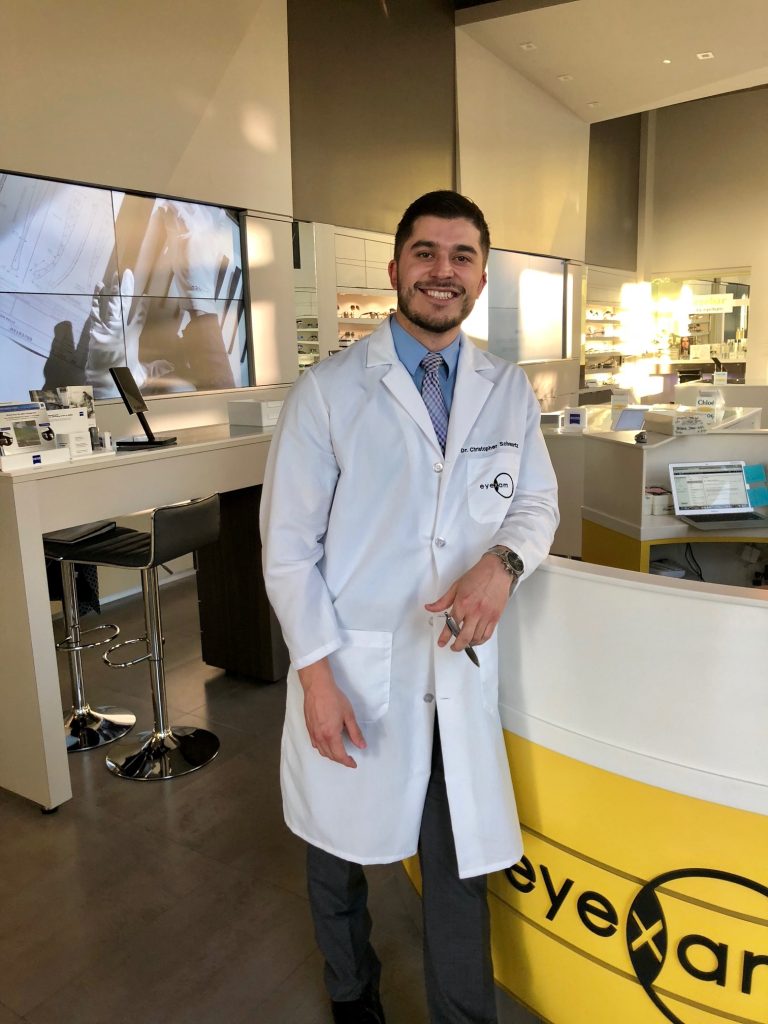 Running a contemporary clinic isn’t without its challenges. This is great news for newer ODs, who are able to capitalize on cutting-edge skills, a knack for technology, and youthful energy. While Dr. Iravani has decades of experience to draw from, she specifically sought out a young optometrist when looking to hire an associate doctor — despite knowing many seasoned and highly experienced colleagues also looking for work. “It is not only my observation, but rather a known fact in our profession that recent grads’ training is much more advanced in many areas such as glaucoma,” she says. “I wanted to complement my industry, business, and contact lens background with a young OD’s strong medical training.”
Running a contemporary clinic isn’t without its challenges. This is great news for newer ODs, who are able to capitalize on cutting-edge skills, a knack for technology, and youthful energy. While Dr. Iravani has decades of experience to draw from, she specifically sought out a young optometrist when looking to hire an associate doctor — despite knowing many seasoned and highly experienced colleagues also looking for work. “It is not only my observation, but rather a known fact in our profession that recent grads’ training is much more advanced in many areas such as glaucoma,” she says. “I wanted to complement my industry, business, and contact lens background with a young OD’s strong medical training.”
Dr. Chris Schwartz, who graduated from the UC Berkeley School of Optometry in 2015, joined the practice because he believes in the need for optometric clinics to distinguish themselves in order to create memorable, positive experiences for patients. “Being in the heart of Silicon Valley, many of our patients are very receptive towards applying the latest advancements in eye care,” says Dr. Schwartz. “Many of them have exceptionally strenuous visual demands, and are looking for doctors that can address their unique needs. eyeXam is well positioned to fill this need by offering some of the latest in refractive and diagnostic technologies. Patients know that when they come in, they will receive top-of-the-line eye care that they will not find many other places.”
Regarding his work with Dr. I, he says, “I have found Dr. Iravani to be an invaluable source of entrepreneurial wisdom, as well as a mentor for general eye care business principles. Her extensive experience across a wide range of eyecare related fields gives her a great deal of perspective on the optometric profession as a whole.” “Dr. Schwartz is not only a great doctor, but also a great team player,” adds Dr. Iravani. “He is always motivated and enthusiastic about adopting new ideas,” which are essential to positioning eyeXam as an industry leader.
Desirable skills such as specialty contact lens fitting, medical model practice, and binocular vision are quite valuable to the modern practice, and young ODs are uniquely positioned to help these practices grow. Even skills outside of clinical care — like the ability to help a practice brand itself on social media — yields dividends to the practice owner. Drs. Iravani and Schwartz use their complementary abilities to provide a wide range of eye care, brainstorm clinical and business ideas, and create a memorable experience for patients.
The Future is Now
Leaving a lasting impression with patients and customers is a must for any successful optometry practice. eyeXam is a great example of effective marketing, patient care, and a modern customer experience, and it can help inspire practice owners to make the jump from old, outdated clinics into the brand-savvy, high-tech, patient-oriented world of the 21st century. Optometrists continue to progress in clinical scope and abilities, and as an industry, our practices need to keep up.


Say Goodbye to Dry Eyes
Do your eyes feel scratchy, gritty, or dry all the time? Are you constantly putting eyedrops in your eyes to keep them moist?
Does computer work, reading, or driving make it even worse?
You might have what they call evaporative dry eye. This happens when the water in your tears evaporates faster than normal, due to an insufficient lipid (oil) layer on the tear film.
That is what causes your eyes to feel dry.
This deficiency of oil may result from a blockage in the oil-producing glands in your eyelids, known as Meibomian Gland Dysfunction (MGD). Sounds so intimidating, right?
Well, don’t worry. eyeXam has a solution called LipiFlow. LipiFlow means relief. LipiFlow treats the leading cause of Evaporative Dry Eye, not just the symptoms. What it does is open and clears blocked glands which allows your body to resume the natural production of lipids (oils) needed for the tear film.
For those of you that like statistics, in a clinical study, 79% of patients reported improvement of their overall dry eye symptoms within four weeks, ranging from 10% to 100% improvement. That is water to eyes wouldn’t you say?
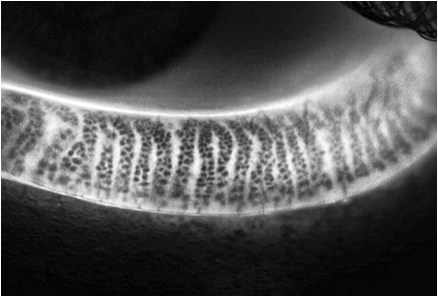
Curious how Lipiflow Works?
LipiFlow Thermal Pulsation technology applies controlled heat to your inner eyelid, and mild intermittent pressure releasing lipids from the blocked Meibomian glands. There is no damage to the glands or the delicate structures of the eye. LipiFlow treats the upper and lower eyelids at the same time.
See how it works:
Some patients consider it somewhat like a spa experience and say it is virtually painless. At eyeXam, it is always our goal to make your visit as happy and comfortable as possible.
Are you a Candidate for Lipiflow? Here’s what to expect at eyeXam.
- We determine the cause of your dry eyes. This is a crucial step in recommending the appropriate treatment option for you.
- Take the dry eye lifestyle questionnaire, (live link)
- Evaluate your symptoms, tear film and gland function to determine the underlying cause of your Dry Eye symptoms.
- Treatment can start immediately.
If you want to say goodbye to your dry, scratchy, itchy eyes, we are here for you.
Schedule your GOODBYE TO DRY EYES appointment. https://www.eyeXam.biz/request-appointment.html
As a loving and gentle reminder. It’s important to treat this chronic disease early, to avoid permanent loss of gland function, additional cell damage, or visual deterioration.
Finally, your eyes will be so happy you found the LipiFlow treatment.
To moist and happy eyes,
Dr. Nikki Iravani
If you are anyone you know suffers from Dry Eyes and wants relief, please let us know how we can help. Contact us at 408-528-7100 or at info@eyeXam.com.
Read More
Make Technology Part of the Experience
 To say that Nikki Iravani, OD, is interested in technology is an understatement. After being vice president of clinical affairs and professional services for CooperVision, she developed the eyeXam™ app, an industry-leading, patented mobile app that offers a self-guided vision screening and GPS-enabled doctor locator.
To say that Nikki Iravani, OD, is interested in technology is an understatement. After being vice president of clinical affairs and professional services for CooperVision, she developed the eyeXam™ app, an industry-leading, patented mobile app that offers a self-guided vision screening and GPS-enabled doctor locator.
So it’s no surprise that when she decided to open her own practice, it had to be a technology-focused center. Her brand new practice, eyeXam, in Santa Clara, California, is in the heart of the Silicon Valley and headquarters for many of the major technology companies. So she set out to create a space that is as focused on a “high-tech/high-touch” experience. “I’m passionate about eye care, everything about it—the clinical experience and the patient engagement,” she says.
She became familiar with the Vision Source® leadership when she was in the corporate world and saw how hard the leaders worked for the members and how much the vendors valued the Vision Source network. It made much more sense to her to open as a member of the network than to go out entirely on her own.

Browse technology
What she has created is the flagship eyeXam location. (Her grand opening, titled Glasses Up, was held in August.) It was built on the idea of having a physical space for the eyeXam app. Patients and visitors are greeted by Xams, her term for technicians who can check them in, show them around, encourage them to browse and respond to their specific needs (similar to the genius concept at Apple stores). When patients walk in, they can walk up to the visionbar to experience the different screening tests on the eyeXam app and other self-guided tests.
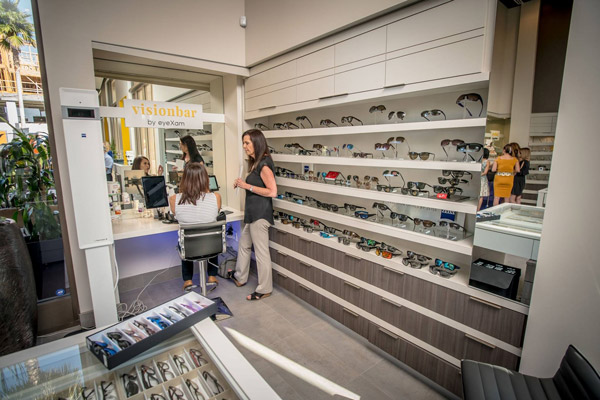
These self-screening tests do not take the place of her comprehensive vision exam, but the idea is to introduce patients to technology. Again, there’s some similarity to an Apple store. “I wanted to create an environment where shoppers can be introduced to the latest advancements in eye technology. It’s an experience. It’s just like the Apple store. Not everyone who walks in wants to buy an Apple watch or iPad that day, but because they’ve had a chance to play with the technology, that’s probably where they’ll come shop,” she says.
Educate and entertain
“I wanted to blend vision care with technology, medical service and fashion from the latest designer brands. At our eyebar, patients can try on colored contact lenses and receive makeup tips for their new eye color,” she says. She’s hired a makeup artist to help any patient who says, “I didn’t put on any makeup today, so I don’t want to shop for new frames. I’m not looking my best.” The makeup artist solves that problem, plus she’ll provide tips for makeup or eyebrow strategies that enhance the frame selected.
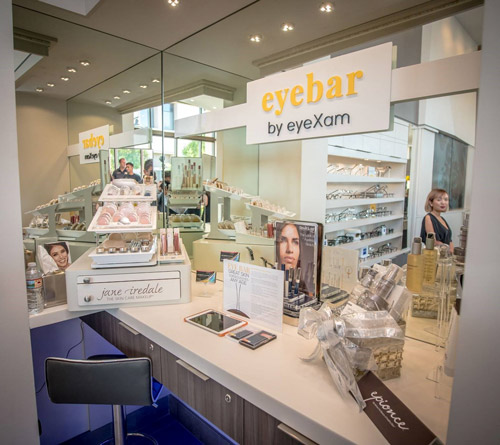
Large video panels on walls display educational and fashion-oriented video loops. As patients walk around, they’re learning about treatments for dry eyes, the latest designer brands and more. “It’s eye care meets Apple meets fashion and beauty,” she says. And it’s an experience unlike any other.

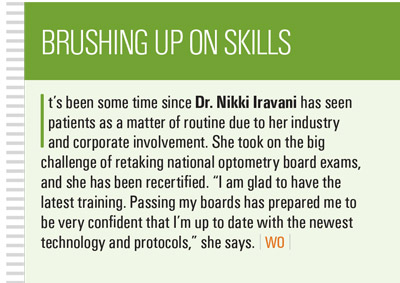
Read More

Home Eye Safety Month – October
The most common place for eye injury to occur is in the yard or garden. One in four eye injuries happen during home repair. However, there are things you can do, both indoors and outdoors, to help protect your eyes and body from unnecessary injury. Here are a few tips for keeping your eyes healthy and safe:
- Wear eye protection, we cannot stress this enough. Eye protection, such as safety goggles, protects your eyes against particles and dust, flying debris and chemicals splashes. Also note that regular corrective lenses do not protect your eyes against injury; you can easily find safety goggles that are worn over your glasses.
- When using hazardous products (e.g., bleach, detergents, cleansers) never mix chemical agents or other caustic substances, always read and follow the manufacturer warnings and guidelines, and always use in well-ventilated areas.
- To improve safety on stairs and walkways remove tripping hazards, secure rugs, install gates on stairs, and provide sufficient lighting and effective handrails. This is especially important in homes and locations where toddlers and senior citizens reside.
- Remove debris and inspect yard and garden before beginning yard work, such as mowing or using a weed trimmer. This measure will not only protect you, but it will prevent potential injury to bystanders.
- Remember to wash your hands after completing a task and before touching your eyes or face.
- Be sure tools and cleaners are out of the reach of children.
- When cooking use shields, as this will prevent hot oils from splashing on your body, face, and especially your into your eyes.
Understandably, we cannot prevent all injuries from occurring. If you should experience an eye injury DO NOT rub or touch the eye, DO NOT apply medication to the eye, and DO NOT attempt to remove any debris from the eye. If the eye injury is caused by a chemical in the eye, thoroughly flush the eye with water. For all eye injuries seek medical attention immediately.
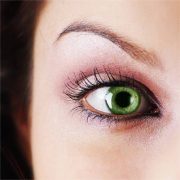
6 Rare and Unique Eye Colors
The eyes certainly are windows to the soul, and if you know anything about eyes or windows, you are aware that they come in many different tints and colors!
Most commonly, you see brown, blue, or hazel eyes when you look at the people around you, but some people, whether it be luck or a medical condition, wind up with a really cool and rare eye color. What are the rarest eye colors and how do they happen?
The Rarest Eye Colors and How They Occur
| Eye Color | Cause(s) |
|---|---|
|
Black
|
An abundance of melanin
|
|
Red/Pink
|
Albinism and blood leaking into the iris
|
|
Amber
|
A little melanin with a large amount of lipochrome
|
|
Green
|
A little melanin, a bunch of lipochrome and Rayleigh scattering of light
|
|
Violet
|
Lack of pigment mixed with light reflecting off of red blood vessels
|
|
Heterochromia
|
Increased or decreased pigmentation in the iris
|
Did You Know?
Only 2% of the world’s population has green eyes! Talk about a rarity! Next time you see someone rocking natural greens, let them in on this cool fact.

So, Which Is the Most Unique?
There really isn’t a way to determine exactly which eye color is the rarest, but if you have never seen any of the ones listed below, just know that it’s because it’s rare. This list is in no particular order, and if your eye color made the cut, consider yourself a gem.
1. Black Eyes
Have you ever seen someone with eyes that seem black as night? Although they appear black, they are really just a very, very dark brown, which is caused by an abundance of melanin. You may only be able to determine the pupil from the iris when looking at the eye with a bright light!
2. Red/Pink Eyes
Two major conditions cause a red or pinkish eye color: albinism and blood leaking into the iris. Although albinos tend to have very, very light blue eyes due to a lack of pigment, some forms of albinism can cause eyes to appear red or pink.
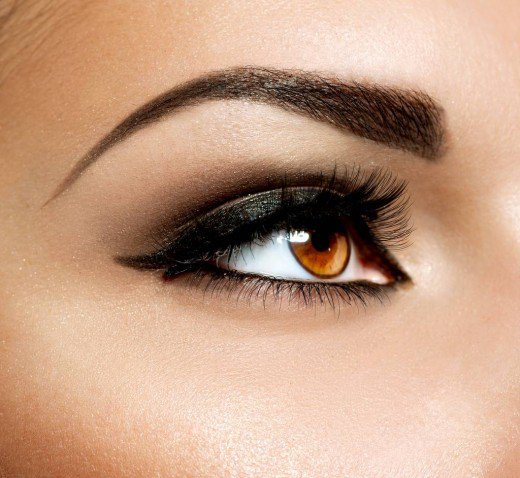
Amber eyes are a beautiful honey color!
3. Amber Eyes
This beautiful, golden eye color is often confused with hazel. The difference is that hazel eyes have brown and green in them, while amber eyes are a solid, uniform color. With a little melanin and a whole lot of lipochrome, eyes of this shade almost appear to be glowing! A few different animals have this eye color, but it’s a true rarity in humans.
4. Green Eyes
Very little melanin, a burst of lipochrome, and the Rayleigh scattering of light that reflects off the yellow stroma can make for a variety of shades of green. With only two percent of the world’s population having green eyes, it’s definitely rare!
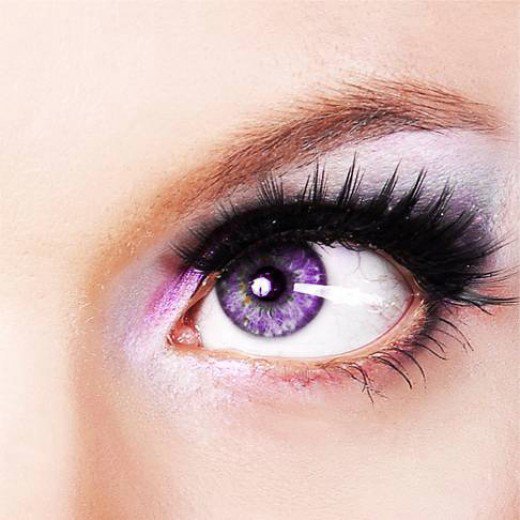
Pretty purple eyes naturally occur because of a lack of pigment, but are very rare.
5. Violet Eyes
Oh, what a purplish blue! This color is most often found in people with albinism. It is said that you cannot truly have violet eyes without albinism. Mix a lack of pigment with the red from light reflecting off of blood vessels in the eyes, and you get this beautiful violet!
6. Heterochromia
This is not a set color, but rather a rare eye condition where either
- one iris is a different color than the other iris (David Bowie!), or
- there is a spot in an iris that is an entirely different color than the rest of the iris due to pigmentation differences.
It’s quite an unusual type of eye coloring that some individuals have, and while many people wear contacts to make their eye color more uniform, I think it’s beautiful, and such a rarity should be flaunted!
What Determines the Color of Your Eyes?
Many people will argue that it is purely genetic, which, for the most part, has been found to be true; however, there’s still not a lot known about the genes that determine a person’s eye color. We do know that rare eye color genes are recessive, so perhaps it’s just a matter of the two right peoples’ genes coming together to bring forth the phenomena.
Now, what we do know about eye color determination is that it involves two pigments (along with how the iris scatters lights): melanin (brown pigment) and lipochrome (a yellow pigment). When you see someone with light, blue eyes, it means there is an absence of melanin, or brown pigmentation.
Originally, we all had brown eyes. But a genetic mutation affecting the OCA2 gene in our chromosomes resulted in the creation of a ‘switch,’ which literally ‘turned off’ the ability to produce brown eyes.
— Professor Hans Eiberg, Department of Cellular and Molecular Medicine, University of Copenhagen
Did We All Have Brown Eyes?
It is believed that the human race started out having brown eyes and due to genetic mutations, other colors came about. Perhaps this is why brown is the most common (but no less beautiful)!
So many people who have perfect vision choose to wear contacts just to have a rare eye color so if you made the cut, consider yourself lucky!
10 Things You Didn’t Know About Your Eyes
